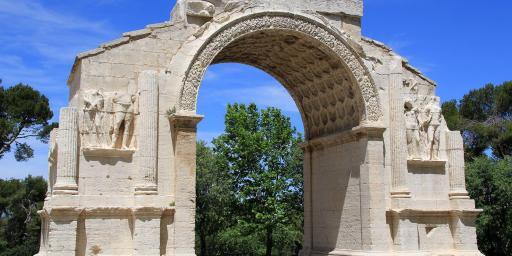Glanum Glorious Views Near St Remy de Provence
Glanum a Roman oppidum, protected by its fortified walls once housed a flourishing community. The settlement stood on a hillside in the shadow of the rocky, crests of the Alpilles slopes. The Franks in 260AD destroyed Glanum. The population was forced to resettle on the valley floor, giving rise to St Remy de Provence.
Today, the busy D5 road, dissects the two well-preserved structures “les Antiques”, the Mausoleum and the oldest triumphal arch in France, from the rest of the Glanum site. The Mausoleum stands 18M high and the arch formerly the southern gate of the community; both are adorned with scenes commemorating the Roman influences. As noisy motorized traffic rushes by, it is difficult to imagine the previous footprint and former glory of this settlement.

Three Phases of Construction
Evidence uncovered from archaeological excavations, which started in 1921, confirm Glanum was actually built in three phases. Glanum I, the initial settlement by a Celtic tribe, the Salyens, dates from the Iron Age about 500BC. Their choice of the site Glanum was deliberate with easy access to water, building materials and higher ground offering some protection from attackers. The Celtics believed that the spring offered healing powers.

Roman authority and Teutonic military occupation punctuated the time-frame for Glanum II (2nd century BC); this was not a period of expansion. In the final phase, Glanum III (1BC to 260AD), the powerful Roman influence is evident as the early colony structures gave way to grander public buildings including the forum and baths.

Construction Recycling
Stones from Glanum were used to construct buildings in St Remy de Provence, and the site was essentially left to rot as the ancient sewers and drains clogged with sediment. Excavations and conservation work occurred in several phases and still continues today. Significantly smaller than other Roman cities like Nimes, Orange and Arles, Glanum was still a prominent Roman cultural centre. Glanum is also much easier to manage than those cites, for a brief historical excursion. When you visit, walk up to the highest point, for the panoramic views of St Remy and the Rhône Valley.
More on Glanum:
Step Back in Time a Visit to Ancient Glanum in St Remy de Provence



No Comment